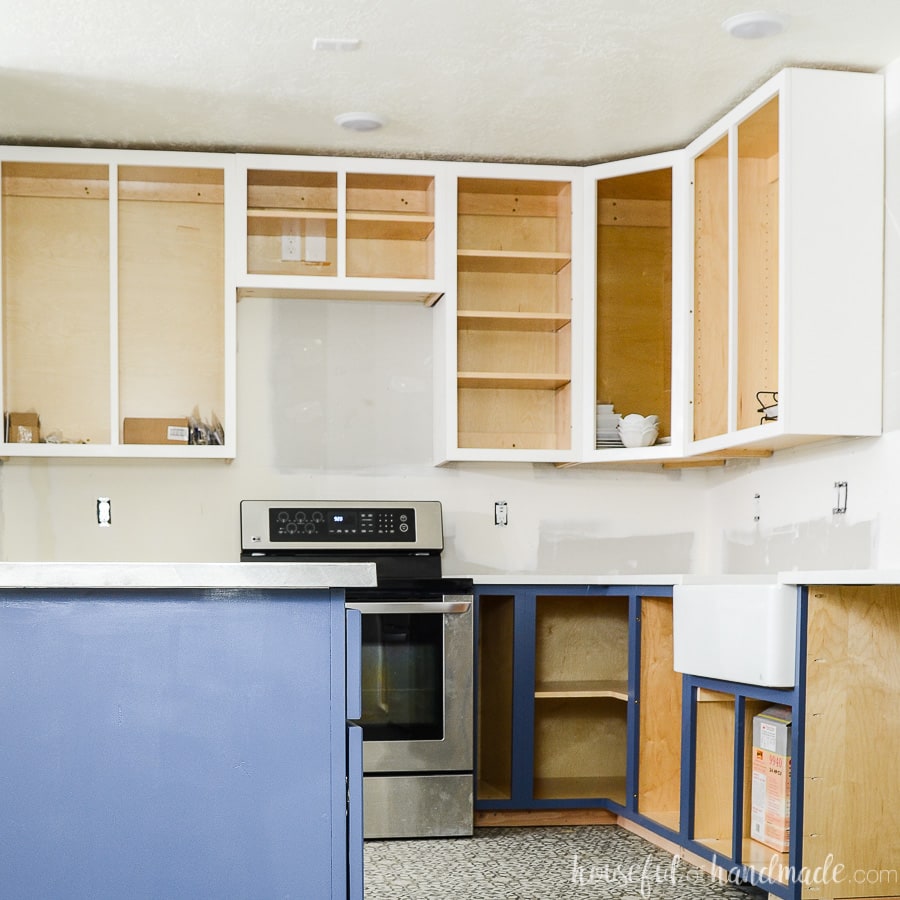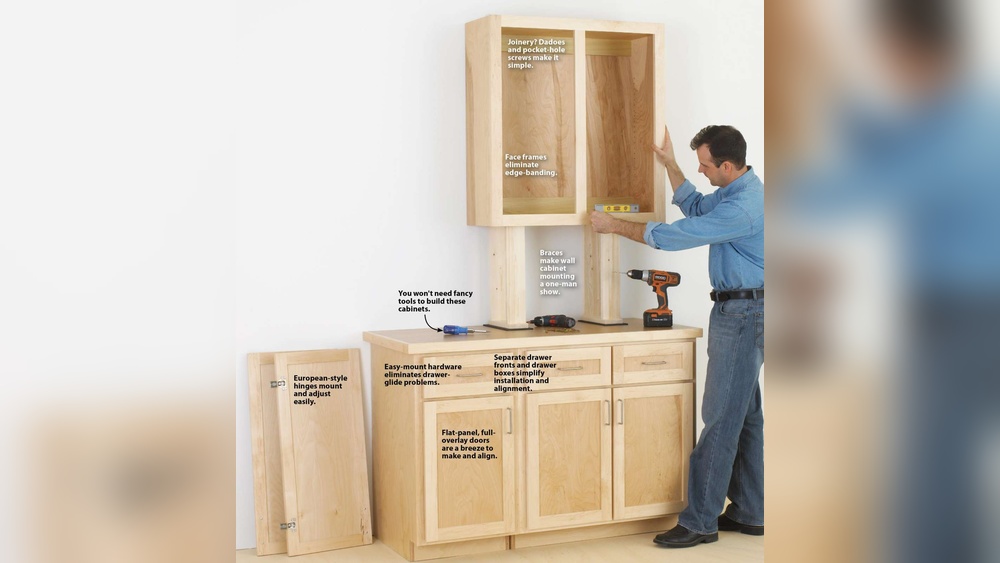Are you ready to transform your kitchen with cabinets that fit your style, space, and budget perfectly? Building your own kitchen cabinets might sound challenging, but with the right steps, tools, and guidance, you can create custom storage solutions that look professional and save you money.
Imagine having cabinets designed exactly the way you want, made from materials you choose, and crafted to last for years. You’ll discover clear, easy-to-follow instructions to help you build kitchen cabinets from start to finish. Whether you’re a beginner or have some woodworking experience, this guide will empower you to take control of your kitchen makeover and enjoy the satisfaction of a job well done.
Keep reading, and let’s get started on building your dream cabinets today!

Materials And Tools
Building kitchen cabinets requires essential materials like plywood, hardwood, screws, and wood glue. These materials form the base and structure of the cabinets.
Must-have tools include a circular saw, drill, measuring tape, clamps, and a screwdriver. These tools help cut, assemble, and secure the cabinet parts.
Choosing quality wood is important for durability and appearance. Common woods are oak, maple, and birch. Plywood is good for cabinet boxes because it resists warping.
It is smart to pick wood that is smooth and free from cracks or knots. This makes the cabinet look better and last longer.
Planning Your Cabinets
Start by measuring your kitchen space carefully. Use a tape measure to get the width, height, and depth of the areas where cabinets will go. Write down each measurement clearly.
Design cabinets that fit your kitchen’s function and style. Think about how you use your kitchen daily. Choose shapes and sizes that make cooking and storage easy. Match colors and materials with your kitchen’s look.
Select cabinet hardware like handles, knobs, and hinges that are both durable and attractive. Pick styles that fit your cabinet design and kitchen theme. Good hardware makes cabinets easier to use.
Cutting And Preparing Wood
Precise measuring and marking of wood pieces is vital. Use a ruler and pencil for accuracy. Mark clearly to avoid mistakes.
Cut wood using the right tools, like a saw or jigsaw. Keep cuts straight and smooth. Take your time to avoid splintering.
Sand each piece carefully to remove rough edges. Start with coarse sandpaper, then use finer grit for a smooth finish. This helps paint or stain stick well.
Assembly Process
Start by assembling the cabinet box. Use strong plywood or MDF panels. Attach the sides to the bottom and back panel with screws. Make sure all corners are square and the box is sturdy. Use clamps to hold pieces while screwing.
Install shelves and dividers next. Measure the inside space carefully. Place shelf supports or dado cuts to hold shelves. Slide shelves into place and secure with screws or nails. Dividers can be added to split space for better storage.
Attach doors and drawers last. Align hinges on doors and screw them to the cabinet box. For drawers, build the box and slide it into the cabinet on runners. Check that doors and drawers open smoothly and adjust if needed.
Finishing Touches
Painting and staining bring color and protect the wood. Choose paint for a smooth, bright finish. Stain shows the wood grain and gives a natural look. Use a brush or spray for even coverage. Let each coat dry well before adding another.
Adding hardware like handles and knobs makes cabinets easy to open. Pick styles that match your kitchen’s look. Measure carefully to place hardware in the right spot. Screw them in tight but avoid cracking the wood.
Sealing protects cabinets from water and wear. Use a clear varnish or polyurethane for long-lasting durability. Apply thin coats and let dry fully. This step helps keep cabinets looking new for years.

Tips For Success
Avoiding common mistakes is key to building strong kitchen cabinets. Measure twice, cut once. Always check your tools for sharpness. Use quality wood and hardware. Avoid rushing the assembly process. Take care with alignment to ensure doors fit well. Sand all surfaces smoothly to prevent splinters.
Time management strategies help keep the project on track. Break tasks into small steps. Set realistic daily goals to avoid feeling overwhelmed. Prepare all materials before starting. Use a timer to stay focused and take short breaks. Keep your workspace organized for efficiency.
Improving woodworking skills makes the project easier and better. Practice simple cuts and joints on scrap wood first. Watch tutorial videos for tips and tricks. Learn how to use different tools safely. Take time to understand the plans and drawings. Patience and practice will improve your results.
Cost Considerations
Budgeting materials and tools is key to manage costs. Basic materials include plywood, screws, hinges, and wood glue. Tools like saws, drills, and sanders add to expenses if not owned. Choosing affordable but durable materials helps save money.
DIY cabinets usually cost less because you avoid labor fees. You control the quality and style. But it takes time and skill to build well. Mistakes can increase costs.
Buying ready-made cabinets is quicker but often more expensive. Custom cabinets cost more but fit perfectly. Standard cabinets save money but may not suit your space.
| Option | Cost | Time | Skill Level |
|---|---|---|---|
| DIY | Lower (if tools owned) | High | Medium to High |
| Buying | Higher | Low | Low |
| Hiring Professional | Highest | Low | None |
Hire a professional if you want perfect results fast. They have skills and tools to avoid errors. This choice fits busy people or those without woodworking experience.

Alternative Options
Ready-to-assemble cabinets offer a budget-friendly option. These come in flat packs and need simple assembly. They save time and effort but have limited styles.
Customizing stock cabinets allows some design freedom. You can paint or change handles to fit your style. It costs less than full custom cabinets and looks unique.
Mixing DIY and professional help can be smart. Doing simple parts yourself cuts costs. Hiring experts for complex tasks ensures good results. This balance saves money and stress.
Frequently Asked Questions
Is It Cheaper To Build Your Own Kitchen Cabinets?
Building your own kitchen cabinets can be cheaper if you have tools, skills, and time. It saves on labor and material costs. Mistakes and tool expenses may reduce savings. Consider your experience and project scope before deciding.
Can A Beginner Build Cabinets?
Beginners can build cabinets by following clear plans and tutorials. Start with basic tools and simple designs. Practice measuring and cutting accurately. Patience and attention to detail improve results. Learning from videos and guides helps build confidence and skills effectively.
What Kind Of Wood To Use To Build Cabinets?
Use hardwoods like maple, oak, cherry, or birch for durable, attractive cabinets. Softwoods like pine suit budget projects. Choose quality plywood or MDF for cabinet boxes. Select wood based on style, budget, and durability needs.
What Are The Three Basic Methods Of Cabinet Construction?
The three basic cabinet construction methods are frameless, face frame, and inset. Frameless uses full panels, face frame adds a front frame, and inset fits doors flush within the frame.
Conclusion
Building kitchen cabinets takes time, patience, and careful work. Follow each step to ensure your cabinets fit well and look good. Use the right tools and measure twice before cutting. Remember, small mistakes can cause bigger problems later. Taking your time helps avoid costly errors.
Custom cabinets give your kitchen a unique and personal touch. Whether for a full remodel or a simple upgrade, building cabinets yourself can be rewarding. Keep practicing and improving your skills with each project. Your effort will show in the final result and your kitchen’s style.

